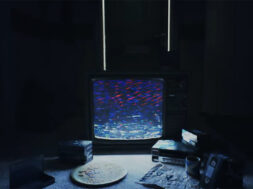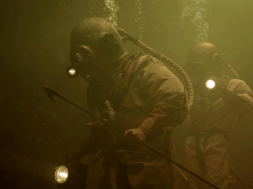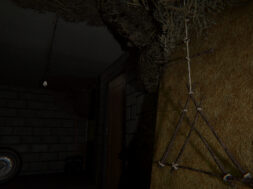In just a few short years, S. Craig Zahler has become a recognizable name within horror and film communities thanks to his unapologetic revelry in exploitation and violence. His feature debut, Bone Tomahawk, shocked audiences with its brutal, nihilistic third act. His follow up, Brawl in Cell Block 99, delivered a deliberately paced descent in into the bowels of a prison for bone-crunching insanity. Then came Puppet Master: The Littlest Reich, a twisted, zany reboot that Zahler only wrote, but his trademark exploitive violence permeates throughout. But his first screenwriting credit, Asylum Blackout (also known as Incident), has become mostly forgotten.
Even the premise bears Zahler’s fingerprint; a group of aspiring musicians work as cooks at a high security institution for the criminally insane, but a storm-induced blackout frees the inmates. The erstwhile musicians are forced to fight for their lives as the inmates prove how depraved they can be. The lead protagonist, George, is played by Rupert Evans (Hellboy, The Boy), and the most demented inmate of them all is played by fan-favorite Richard Brake (31, Mandy, Game of Thrones). Director Alexandre Courtès makes his feature debut; he’d previously been known for his music video work until this point. A Belgian-French production, you can bet Asylum Blackout gets brutal. Yet not nearly as brutal as you’d expect.

After a pretty graphic cut to the finger in the opening scenes that introduce us to George and his friends as they meal prep in the asylum kitchen, it takes its time before getting to the blackout. This is just as well, considering it can get a little repetitive once the lights go down. When it does go full throttle on the violence, we get scenes like a vegetable peeler grating away a victim’s skin, decapitations, metal rods to the gut, a nose gruesomely bitten off, and more. The blood flows freely, and it looks great. Key special effects makeup was handled by Jean-Christophe Spadaccini and Denis Gastou (City of the Lost Children). Spadaccini had previously worked on Gaspar Noe’s Irreversible and I Stand Alone, so he’s clearly well versed in cringe-inducing effect work. Most of the gore is practical, but there are obvious uses of digital effects as well.
Asylum Blackout also boasts one more secret weapon in its editor; Baxter. A frequent collaborator of Alexandre Aja, Julien Maury, and Alexandre Bustillo’s, Baxter has also worked on High Tension, The Hills Have Eyes (2006), Inside, Piranha 3D, Livid, Maniac (2012), and more. In other words, if you’re ever working on an extreme horror film, Baxter is the one you want editing it.
In the end, Asylum Blackout is a straightforward exploitation horror film that fulfills its purpose. It’s violent and gruesome, but never quite gets as extreme as it could. By Zahler’s standards, it can be pretty tame for most of the runtime. There’s also a last-minute ending tacked on by writer Jérôme Fansten that undoes most of the goodwill earned up until that point, and it’s what drew critical ire during the film’s release in 2012. It also probably didn’t help that IFC Midnight snatched up this one following reports of people fainting during its screening at the Toronto International Film Festival. Nothing will overhype a horror movie and deflate it just as quickly than that. Existing at a cross roads of Zahler’s exploitation-based sensibilities and French extreme horror, Asylum Blackout is an entertaining movie worth the watch just for Brake’s performance alone.










